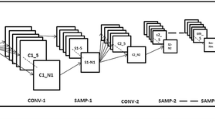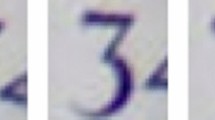Abstract
Deep learning architectures use a set of layers to learn hierarchical features from the input. The learnt features are discriminative, and thus can be used for classification tasks. Convolutional neural networks (CNNs) are one of the widely used deep learning architectures. CNN extracts prominent features from the input by passing it through the layers of convolution and nonlinear activation. These features are invariant to scaling and small amount of distortions in the input image, but they offer rotation invariance only for smaller degrees of rotation. We propose an idea of using multiple instance of CNN to enhance the overall rotation invariant capabilities of the architecture even for higher degrees of rotation in the input image. The architecture is then applied to handwritten digit classification and captcha recognition. The proposed method requires less number of images for training, and therefore reduces the training time. Moreover, our method offers an additional advantage of finding the approximate orientation of the object in an image, without any additional computational complexity.
Access this chapter
Tax calculation will be finalised at checkout
Purchases are for personal use only
Similar content being viewed by others
References
Yann LeCun and Yoshua Bengio. Convolutional networks for images, speech, and time series. The handbook of brain theory and neural networks, 3361(10):1995, 1995.
Sajjad S Ahranjany, Farbod Razzazi, and Mohammad H Ghassemian. A very high accuracy handwritten character recognition system for farsi/arabic digits using convolutional neural networks. In Bio-Inspired Computing: Theories and Applications (BIC-TA), 2010 IEEE Fifth International Conference on, pages 1585–1592. IEEE, 2010.
Chao Dong, Chen Change Loy, Kaiming He, and Xiaoou Tang. Image super-resolution using deep convolutional networks. IEEE transactions on pattern analysis and machine intelligence, 38(2):295–307, 2016.
Fok Hing Chi Tivive and Abdesselam Bouzerdoum. Rotation invariant face detection using convolutional neural networks. In International Conference on Neural Information Processing, pages 260–269. Springer, 2006.
D. Wu, L. Pigou, P. J. Kindermans, N. D. H. Le, L. Shao, J. Dambre, and J. M. Odobez. Deep dynamic neural networks for multimodal gesture segmentation and recognition. IEEE Transactions on Pattern Analysis and Machine Intelligence, 38(8):1583–1597, 2016.
B. Fasel and D. Gatica-Perez. Rotation-invariant neoperceptron. In 18th International Conference on Pattern Recognition (ICPR’06), volume 3, pages 336–339, 2006.
Shih-Chung B Lo, Heang-Ping Chan, Jyh-Shyan Lin, Huai Li, Matthew T Freedman, and Seong K Mun. Artificial convolution neural network for medical image pattern recognition. Neural networks, 8(7):1201–1214, 1995.
Dmitry Laptev, Nikolay Savinov, Joachim M. Buhmann, and Marc Pollefeys. TI-POOLING: transformation-invariant pooling for feature learning in convolutional neural networks. CoRR, arXiv:1604.06318, 2016.
Max Jaderberg, Karen Simonyan, Andrew Zisserman, and Koray Kavukcuoglu. Spatial transformer networks. CoRR, arXiv:1506.02025, 2015.
Yann LeCun, Léon Bottou, Yoshua Bengio, and Patrick Haffner. Gradient-based learning applied to document recognition. Proceedings of the IEEE, 86(11):2278–2324, 1998.
Yann LeCun and Corinna Cortes. Mnist handwritten digit database. AT&T Labs [Online]. Available: https://yann.lecun.com/exdb/mnist, 2010.
Author information
Authors and Affiliations
Corresponding author
Editor information
Editors and Affiliations
Rights and permissions
Copyright information
© 2018 Springer Nature Singapore Pte Ltd.
About this paper
Cite this paper
Jain, A., Sai Subrahmanyam, G.R.K., Mishra, D. (2018). Rotation Invariant Digit Recognition Using Convolutional Neural Network. In: Chaudhuri, B., Kankanhalli, M., Raman, B. (eds) Proceedings of 2nd International Conference on Computer Vision & Image Processing . Advances in Intelligent Systems and Computing, vol 703. Springer, Singapore. https://doi.org/10.1007/978-981-10-7895-8_8
Download citation
DOI: https://doi.org/10.1007/978-981-10-7895-8_8
Published:
Publisher Name: Springer, Singapore
Print ISBN: 978-981-10-7894-1
Online ISBN: 978-981-10-7895-8
eBook Packages: EngineeringEngineering (R0)




